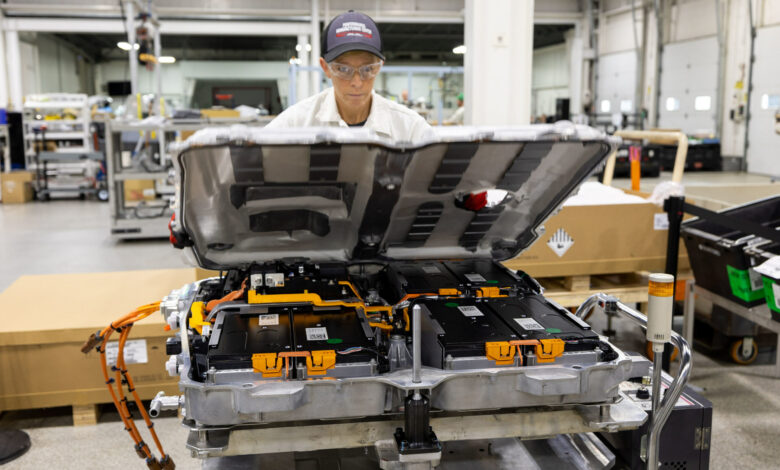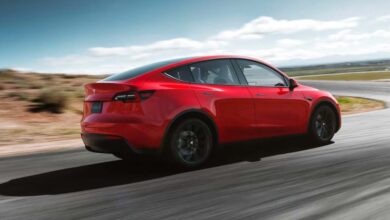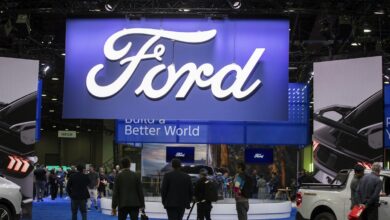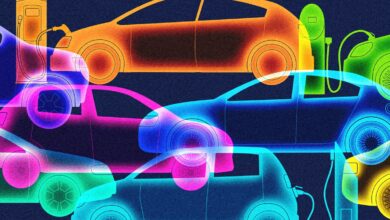Honda begins production of new CR-V fuel cell electric vehicle in Ohio

Honda has begun production of its all-new 2025 CR-V fuel cell electric vehicle (FCEV) at the Performance Manufacturing Center (PMC) in Ohio.
Honda says the CR-V e:FCEV is the only FCEV made in America and the first production hydrogen FCEV (using domestic and globally sourced parts) in the country to combine an all-new U.S.-made fuel cell system with plug-in EV charging capability.
The crossover utility vehicle (CUV) received a 270-mile EPA driving range rating, combining the fuel cell system with plug-in charging to provide up to 29 miles of EV driving around town, Honda said. It also has the flexibility of fast hydrogen refueling for longer trips, according to a news release from the OEM.
Honda says refueling with hydrogen takes about the same time as filling a tank with gasoline and recharging the takes 1.8 hours using a Level 2 charger.
The Honda CR-V e:FCEV features Honda’s Power Supply Connector turning the CUV into a clean power source capable of running small home appliances, power tools, or camping equipment, the release states.
“The Performance Manufacturing Center was conceived as a small volume manufacturing facility with a focus on craftsmanship, and I’m proud of how our production technicians leveraged their experience building the Acura NSX to take on the challenge of making this all-new Honda CR-V e:FCEV,” said Patrick McIntyre, lead of PMC, in the release. “Producing a zero-emission fuel cell electric vehicle is one more step toward Honda’s global goal of achieving carbon neutrality for our products and operations.”
Honda engineers optimized the CR-V e:FCEV’s steering and suspension tuning to deliver “the same sporty driving experience and class-leading refinement as turbo and hybrid-powered CR-V models,” Honda said. Drivers can also pick from varying drive modes, including EV modes, to maximize efficiency and a Sport mode to prioritize acceleration and responsiveness, according to the release.
The CR-V e:FCEV’s next-gen fuel cell system is also made in the U.S. at Fuel Cell System Manufacturing LLC, in Brownstown, Michigan — the joint venture production facility established by Honda and General Motors. The new fuel cell system was co-developed by Honda and GM, achieving higher efficiency and increased refinement, with durability performance doubled and cost reduced by two-thirds compared to the previous fuel cell system in the Honda Clarity Fuel Cell, the release states.
Production of the FCEV at the PMC lays the software groundwork for production of battery electric vehicles at the Honda EV Hub in Ohio. The hub will produce Honda EVs in North America, fitting with the OEM’s vision for battery electric and fuel cell EVs to represent 100% of its new vehicle sales by 2040.
Production technicians at PMC navigated several challenges related to new production equipment and processes to effectively transition from building the Acura NSX supercar to the Honda CR-V e:FCEV, according to Honda.
That included:
-
- New components: PMC technicians are taking on multiple new assembly processes specific to producing a vehicle powered by both a fuel cell system and a plug-in EV battery, requiring multiple connections for the vehicle’s two power sources and the Power Supply Connector that can provide electrical power for various external devices.
- Sub-assembly of two hydrogen tanks, attaching high-pressure piping and other parts, and then installing the tanks in the vehicle
Compressing hydrogen to 10,000 PSI via a new onsite station used to fill the CR-V e:FCEV hydrogen fuel tanks - Installation of the fuel-cell system along with connecting high-pressure piping and wiring
- Sub-assembly and installation of the under-floor battery
New Weld System: Transitioning to the CR-V e:FCEV required a complete transformation of the Weld Department, from a highly-automated welding system created for an aluminum spaceframe to a multi-material unibody construction. - The previous robotic weld system was removed and replaced with new steel welding robots which were installed with characteristics of a traditional weld system but are unique from mass production plants with a flexible fixture system that rolls around on a track.
- PMC technicians also now perform some manual MIG welding to apply welds that are difficult for robots to reach to attach closure parts for the doors, hood, and tailgate.
- Paint System Modifications: The larger and heavier all-steel body of the CR-V e:FCEV requires a different corrosion protection application process than the smaller, all-aluminum Acura NSX.
The CR-V e:FCEV is the first vehicle Honda North America has applied zirconium to a mixed metal uni-body that uses the same high-appearance paint coating as the NSX.
The E-coat dip tank was designed for the smaller surface area of the NSX spaceframe, not a full-frame vehicle like CR-V with more surface area inside, so engineers had to modify the dip tank to enable the CUV body shape to enter at a 38-degree angle — steeper than the 15-degree angle for NSX, Honda said.
More precise control of the e-coat pumps was also required for CR-V to create higher circulation of the E-coat to cover the surface area inside the frame, according to the release.
Following e-coating and before the final paint finish sealer is applied to prevent water leaks. The CR-V body is mounted on a rotisserie, but unlike the previous equipment arm used to turn the lighter NSX spaceframe, a more robust arm that can maintain the stability of the heavier CR-V steel frame is used to turn the frame on its side, the release states. This enables associates to manually apply sealer similar to the application for the NSX.
Honda Electrification Strategy
Honda recently announced plans to build a comprehensive EV value chain in Canada with an investment of $11 billion to strengthen its EV supply system and capability to prepare for a future increase in EV demand in North America, the release states.
As Honda accelerates preparation for EV production, the company says it plans to sustain current ICE and hybrid EV production to meet continued strong customer demand. Honda plans to use sales growth of ICE and hybrid-electric vehicles to support its investment in an electrified future.
Images
Featured image: A Honda associate at the Performance Manufacturing Center in Marysville, Ohio subassembles the Integrated Power Unit case for the 2025 CR-V e:FCEV. (Provided by Honda)
The 2025 CR-V e:FCEV in the vehicle quality area at the Performance Manufacturing Center. (Provided by Honda)
Share This:



